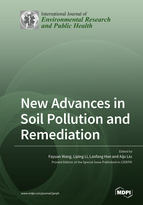New Advances in Soil Pollution and Remediation
A special issue of International Journal of Environmental Research and Public Health (ISSN 1660-4601). This special issue belongs to the section "Environmental Science and Engineering".
Deadline for manuscript submissions: closed (30 June 2022) | Viewed by 22989
Special Issue Editors
Interests: soil pollution and remediation; ecotoxicity of environmental pollutants; emerging contaminants; arbuscular mycorrhizae; phytoremediation; ecotoxicology and environmental risks; heavy metals; ecological restoration
Special Issues, Collections and Topics in MDPI journals
Interests: heavy metal; soil; health risk; wheat; bioavailability
Special Issues, Collections and Topics in MDPI journals
Interests: soil remediation; natural organic matter; carbon sequestration; biochar; microplastics
Special Issues, Collections and Topics in MDPI journals
Special Issue Information
Dear Colleagues,
Soil pollution has been identified as a global environmental issue, posing potential risks for soil ecosystems, food security, and human health. Recently, the Global Assessment of Soil Pollution report, jointly issued by FAO and UNEP, caught our attention on this topic again. As the report pointed out: “Soil pollution hampers the achievement of Sustainable Development Goals (SDGs), including achieving zero hunger, ending poverty, ensuring healthy lives and human well-being, halting and reversing land degradation and biodiversity loss, and making cities safe and resilient.” Therefore, effective soil remediation technologies, including physical, chemical and biological approaches, are required in order to make the polluted soils safer for humans and other organisms. In addition to traditional pollutants, such as heavy metals and persistent organic pollutants, soils are also being contaminated by emerging contaminants, such as microplastics, nanoparticles, antibiotics, perfluorinated compounds, polybrominated diphenyl ethers, personal care products, and flame retardants. Due to their emerging state, little information is available on the occurrence and contamination status of these emerging contaminants in the soil environment, which needs to be urgently investigated. Meanwhile, soil contamination by these contaminants calls for more novel and effective soil remediation techniques. This Special Issue focuses on soil pollution with both traditional and emerging contaminants, as well as novel and green remediation technologies.
This Special Issue is open to all aspects related to soil pollution and remediation, particularly emerging contaminants in soils, and novel soil remediation materials and technologies. Studies on the occurrence, fate, risks, toxicity, and ecological impacts of soil contaminants are also welcome. The listed keywords represent a few of the priorities.
Contributions can include, but are not limited to:
- Occurrence, fate, and transformation of contaminants in soil;
- Monitoring and assessment of soil contaminants;
- Risks, toxicity, and ecological effects of soil contaminants;
- Development and applications of novel materials for soil remediation;
- Development and applications of novel technologies for soil remediation.
Prof. Dr. Fayuan Wang
Prof. Dr. Liping Li
Dr. Lanfang Han
Dr. Aiju Liu
Guest Editors
Manuscript Submission Information
Manuscripts should be submitted online at www.mdpi.com by registering and logging in to this website. Once you are registered, click here to go to the submission form. Manuscripts can be submitted until the deadline. All submissions that pass pre-check are peer-reviewed. Accepted papers will be published continuously in the journal (as soon as accepted) and will be listed together on the special issue website. Research articles, review articles as well as short communications are invited. For planned papers, a title and short abstract (about 100 words) can be sent to the Editorial Office for announcement on this website.
Submitted manuscripts should not have been published previously, nor be under consideration for publication elsewhere (except conference proceedings papers). All manuscripts are thoroughly refereed through a single-blind peer-review process. A guide for authors and other relevant information for submission of manuscripts is available on the Instructions for Authors page. International Journal of Environmental Research and Public Health is an international peer-reviewed open access monthly journal published by MDPI.
Please visit the Instructions for Authors page before submitting a manuscript. The Article Processing Charge (APC) for publication in this open access journal is 2500 CHF (Swiss Francs). Submitted papers should be well formatted and use good English. Authors may use MDPI's English editing service prior to publication or during author revisions.
Keywords
- Soil pollution
- Soil pollutants
- Emerging contaminants
- Soil community
- Soil remediation
- Organic pollutants
- Degradation
- Heavy metals
- Bioavailability
- Accumulation
- Ecological impacts
- Ecotoxicology









